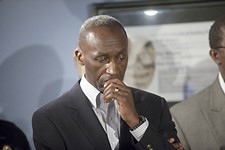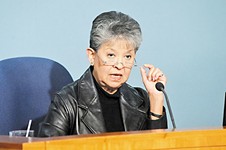Hockenyos Gets Creative ... Again
Austin should embrace its identity as a cultural mecca
By Mike Kanin, Fri., March 30, 2012
This is a banner time of year for Austin: What passes for winter south of the Red River has eased – just in time for the badge-sporting masses to swarm the cash registers along the corridors happily lent to South by Southwest. And this year, spring has been compounded by a very cheery item from City Hall: On March 8, favorite local economist Jon Hockenyos presented a study that suggests that Austin's creative industries were responsible for more than $4 billion in economic activity in 2010. The report put an exclamation point on South by, but it also goes deeper, suggesting that the city should embrace its identity as a cultural mecca. "This is who we are; this is what we are fundamentally good at," said Hockenyos in a phone interview just as the Festival tidal wave was about to crest. "There is more going on here than what the world fully realizes."
Even before economist Richard Florida anointed us as the second-most-creative place in the nation in his 2002 book, The Rise of the Creative Class, the possibility of making both a quantifiable boon and a provable asset out of Austin's artist community has provided local politicos and their minions with reason to play with data. In the early 2000s, Hockenyos' firm, TXP, looked separately at music, nonprofit arts, and film. In 2006, TXP tried to mush it all together. That effort produced a document that, as the Chronicle's Robert Faires wrote at the time ("Arts and the Economy," The Arts, April 14, 2006), argued "the arts make ... a crucial contribution to a city's quality of life, which attracts more business, which boosts the economy still further" – it was, as Faires parenthetically added, "the 'creative class' argument popularized by Richard Florida, who's quoted more than once in TXP's report." The 2006 study put arts-related contributions to Austin's economy at roughly $2.2 billion.
The "-related" part earns the Florida model a hefty bit of criticism. As Michael Erard wrote in 2004, "[Florida's] academic peers ... take issue with his definition of the 'creative class,' which includes everyone from pro basketball players and computer programmers to lawyers and fine painters." (See "Naked City," May 21, 2004; also, Erard's "Creative Capital?," Feb. 28, 2003.) Though a portion of Hockenyos' study covers a handful of odd items – the economic contributions of coaches and umpires seem particularly out of place – he insists that the meat of his 2012 study doesn't stretch the definition of "arts" categories. Better yet, this latest stab at cultivating the economics of Austin's art scene might actually contain concrete, workable suggestions.
Since Florida's book and the earlier studies, the city has grown into its status as a cultural capital. Indeed, according to Hockenyos' 2012 effort, "the creative sector in Austin's economy (as measured by employment) has risen by about twenty-five percent over the past five years, a pace more rapid than the ten percent growth for the local economy as a whole." As is evidenced by the remarkable growth of SXSW, the wider investing world seems to believe that Austin is, indeed, a worthy cultural destination. In other words, the hard and intangible part – the establishment of status – has been somewhat completed, which allows the city to focus on the tangible actions it needs to take to tend to its Meccadom.
This time around, Hockenyos also gives city officials reason to refocus their cultural attention on gaming and digital media. "[G]ame designers are able to access venture capital funding that other creative sectors cannot," he wrote. "Investors are drawn to innovative technology and the link between new games and these technologies." That history reinforces continued city attempts to attract all sorts of high tech industries, already an achievable goal.
Not that all of Hockenyos' recommendations will meet with acclaim. For live music support, Hockenyos tells his readers: "The regulatory environment (particularly in the central city) has to accommodate the needs of the entertainment industry" – that is, regulation that affects live music he calls "one of the trickiest [factors in play] ... as the urbanist approach to central-city redevelopment ... runs head-on into sound ordinances, parking issues, and the fact that from a real estate perspective the highest and best use of many venues may no longer be as a place to see music." Gentrification issues aside, the idea of relaxing sound regulations in favor of more live music is the sort of thing that about a thousand neighborhood organizations might oppose. Good luck with that.
Still, Council Member Kathie Tovo – herself an NA favorite – welcomed the study, calling the ability to quantify the artistic contributions to the local economy "important" and saying it helps make the city "able to make [the] argument" that investment in culture is a worthwhile enterprise. The bulk of the recommendations of the 2012 study are solid, reasonable, even implementable: Increased support of artistic infrastructure, a bridge between idea-havers and financing, mobility planning that could better support arts tourism, and promotional and branding ideas that remind people about the breadth of culture the city boasts.
Of course, support for the arts – practical or otherwise – is not automatically rubber-stamped. But the artist-friendly image has been embraced by the city, meaning that taxpayer-funded incentives – such as the bond funding for Austin Studios cited in Hockenyos' report or the pilot grant that the city will offer for live music sound mitigation – often escape the criticism aimed at other "corporate" economic incentives, although the latter may bring greater economic return.
For his part, Hockenyos sees his current study as a starting point. "My report should be viewed as the beginning of the conversation," he says. Beginning? Not really. But first to come up with a set of workable proposals? Looks like it.
Got something to say on the subject? Send a letter to the editor.











